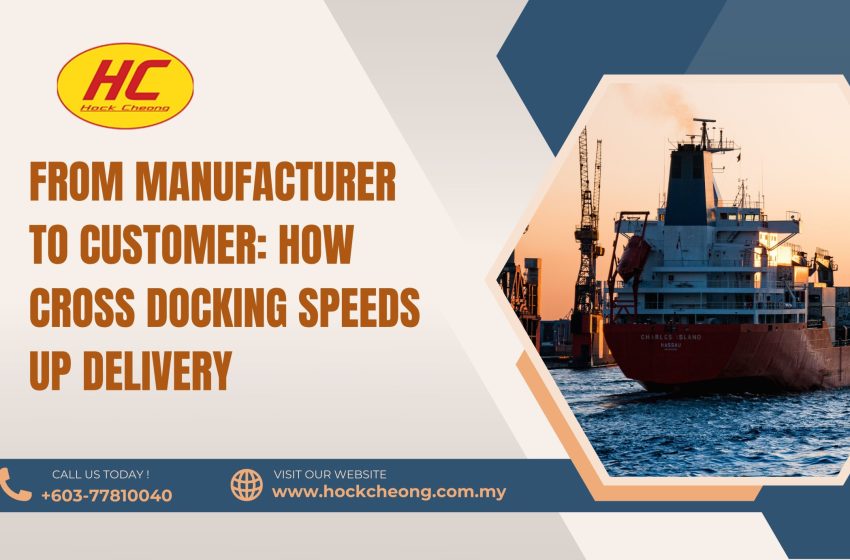From Manufacturer to Customer: How Cross Docking Speeds Up Delivery

In the fast-paced world of modern commerce, the efficiency of supply chain operations can make or break a business. One strategy that has gained significant traction for its ability to expedite delivery times is cross docking. By minimizing storage time and streamlining the flow of goods from manufacturer to customer, cross docking offers a competitive edge that can enhance customer satisfaction and reduce operational costs. In this blog, we’ll explore how cross docking works, its benefits, and why it might be the right choice for your business.
Understanding Cross Docking
Cross docking is a logistics strategy where products are directly transferred from inbound to outbound transportation with minimal or no storage time in between. This process involves unloading materials from incoming trucks, sorting and screening them as necessary, and immediately loading them onto outbound trucks for delivery. Essentially, cross docking acts as a hub where goods are rapidly transferred rather than stored in a warehouse for an extended period.
The Cross Docking Process
· Receiving: Products arrive at the cross docking facility from various manufacturers or suppliers.
· Sorting and Screening: Goods are quickly sorted based on their destinations and sometimes inspected for quality assurance.
· Loading: Sorted products are immediately loaded onto outbound transportation, which could be delivery trucks heading to retail stores, distribution centers, or directly to customers.
· Shipping: The products are shipped to their final destinations, ensuring swift delivery times.
Benefits of Cross Docking
· Reduced Storage Costs: Traditional warehousing involves significant storage costs, including rental fees, utilities, and labor for managing inventory. Cross docking minimizes these expenses by reducing or eliminating the need for long-term storage.
· Faster Delivery Times: By cutting down the time goods spend in storage, cross docking speeds up the overall delivery process. Products move swiftly from manufacturer to customer, often reaching their destinations within hours or days.
· Improved Inventory Management: Cross docking reduces the need to maintain large inventories, allowing businesses to operate with leaner inventory levels. This leads to better cash flow and reduces the risk of overstocking or stockouts.
· Enhanced Customer Satisfaction: Faster delivery times mean customers receive their orders more quickly, leading to higher satisfaction rates and potentially increased customer loyalty.
· Environmental Benefits: With fewer storage facilities and reduced inventory levels, cross docking can contribute to lower energy consumption and a smaller carbon footprint, aligning with sustainability goals.
Types of Cross Docking
· Pre-Distributed Cross Docking: In this model, products are already sorted and labeled for specific destinations before arriving at the cross-docking facility. This minimizes sorting time and speeds up the transfer process.
· Post-Distributed Cross Docking: Here, goods arrive in bulk and are sorted at the cross-docking facility according to their final destinations. This method allows for more flexibility in handling various products from different suppliers.
Industries Benefiting from Cross Docking
Several industries have embraced cross-docking to enhance their supply chain efficiency:
· Retail: Retailers use cross-docking to manage seasonal inventory spikes and ensure timely restocking of shelves. This is particularly useful during holiday seasons or promotional events.
· E-commerce: Online retailers benefit from faster order fulfillment and reduced storage costs, allowing them to offer quicker delivery options to customers.
· Automotive: The automotive industry uses cross docking to streamline the supply of parts and components, reducing downtime in manufacturing and repair processes.
· Perishables: Industries dealing with perishable goods, such as food and pharmaceuticals, utilize cross docking to maintain the freshness and quality of products by minimizing storage time.
Challenges of Cross Docking
While cross docking offers numerous benefits, it also presents some challenges:
· Coordination and Timing: Effective cross docking requires precise coordination between inbound and outbound shipments. Any delays can disrupt the entire process.
· Infrastructure and Technology: Implementing cross docking may require significant investment in infrastructure and technology, such as advanced sorting systems and real-time tracking.
· Supplier Collaboration: Successful cross docking relies on strong collaboration with suppliers to ensure timely delivery and quality control.
Implementing Cross Docking in Your Business
To implement cross docking, consider the following steps:
· Assess Feasibility: Evaluate whether cross docking aligns with your business model and supply chain requirements. Consider factors such as product types, order volumes, and delivery schedules.
· Invest in Technology: Implement advanced logistics software to manage real-time tracking, sorting, and coordination of shipments.
· Optimize Facility Layout: Design your cross docking facility to facilitate smooth and efficient transfer of goods, with clear pathways for sorting and loading.
· Train Staff: Ensure your workforce is well-trained in cross docking procedures and understands the importance of timely and accurate handling of products.
· Monitor and Improve: Continuously monitor the performance of your cross docking operations and make improvements as needed to enhance efficiency.
Conclusion
Cross docking is a powerful logistics strategy that can significantly speed up the delivery process, reduce costs, and improve customer satisfaction. By minimizing storage time and streamlining the flow of goods from manufacturer to customer, cross docking offers a competitive edge in today’s fast-paced market. If you’re looking to enhance your supply chain efficiency and deliver superior customer experiences, cross docking might be the solution your business needs.

